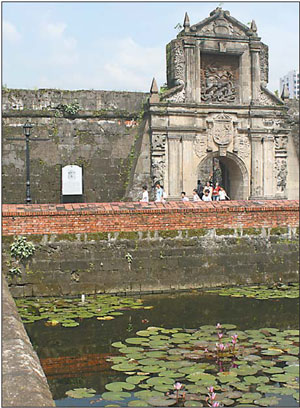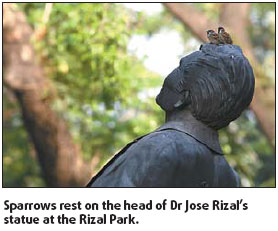Finding a city's charms amid the frenzy
 |
| Water lilies in a pond of Fort Santiago in Manila. |
In fact, Manila doesn't appear to have tourist appeal for travelers who have got used to seeing magnificent palaces, temples, mansions, or glossy highrises in other major metropolises of the region.

Most of its fine Spanish colonial buildings and pre-war neighborhoods were flattened by American and Japanese bombs in World War II, and its infrastructure was eroded by years of political turmoil and neglect.
No matter if your first impression is good or not, however, your trip to the country often has to start and end in this city. With the time of stopovers and just a little will of adventure, you can and will uncover its charms.
Stretching from Taft Avenue toward Manila Bay is a 128-acre (52-hectare) park in the center of Manila. Flowers, fountains, wide lawns and plenty of music attract thousands of strolling Filipinos every day in the late afternoon and evening. There Manilans can jog, do tai chi, stroll through the Chinese Garden, a pleasant arboretum, or just lie on the grass.
The park is named after the national hero Jose Rizal who was, among other things, a doctor, linguist, botanist, novelist, poet, educator and fencer. Executed in 1896 by the Spanish because of his reformist views, he was originally buried at Paco Park but now lies under the Rizal Memorial, designed by Swiss artist Richard Kissling and erected in 1912.
The dramatic scene of the execution squad taking aim is the theme of a group of statues near the Rizal Memorial. Rizal's farewell poem, Ultimo Adios (Last Farewell), is inscribed on a bronze plaque in different languages.
If you're there at 5 am, you can see birds chirping and feeding on the lawn where the statues are erected. Next door to the memorial, elderly Chinese play tai chi or fan dance in the pavilion of the beautiful Chinese Garden.
Rizal Park is one of the city's main meeting places. To the north is Intramuros, the Spanish fortress badly damaged during fierce fighting in WWII. To the south are the tourist areas of Ermita and Malate. Its main street is the waterfront Roxas Boulevard, also known as the Philippines' Sunset Boulevard.
In Intramuros, literally the city in walls, Fort Santiago is the most important structure with vital defence location. From this strategic location, at the mouth of the Pasig River, all Manila Bay can be observed.
Previously used by the Spanish, Americans and Japanese, it's now a pleasant park with an open-air theater where plays are staged among the ruins. Strolling in the fortress, one can see ponds covered by water lilies, vivid statues of Spanish colonists and good views of the river and the old part of Manila.
Another treasure hidden among the urban chaos of Manila is the Manila American Cemetery & Memorial.
A well-maintained garden with rampant tropical trees, green lawns and lines of white cross tombstones, the place is one of few places in the capital where you can get a feel of solitude and peace.
A day in Manila will not be considered perfect without enjoying the Manila sunset along the "Sunset Boulevard".
It might be a little crowded, but is still the best place to get a glimpse of the locals' laid-back lifestyle. Sitting on the bank of the coast to chitchat, having snacks by street stands, or listening to the live music staged by street musicians, they shows their obvious love to the city.
Finally you can finish your stopover in Manila with a dinner at Ang Bistro sa Remedio. Claimed to be "the best of 20 years in Filipino cuisine", the restaurant at the corner of Remedios and Adriatico Streets features such delicacies as Baked Tahong (baked mussels in butter and garlic), crispy crabs, and Binukadkad na Crispy Pla Pla (deep-fried Pla Pla fish).
(China Daily 08/23/2007 page19)














